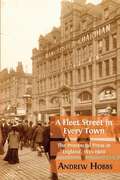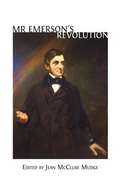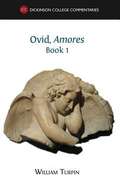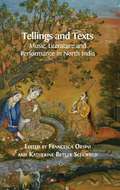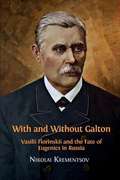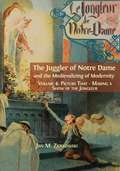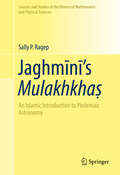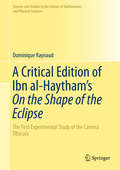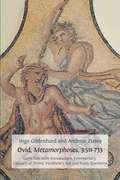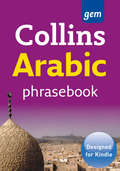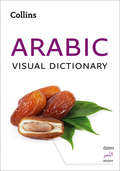- Table View
- List View
From Dust to Digital: Ten Years Of The Endangered Archives Programme
by Maja KominkoMuch of world’s documentary heritage rests in vulnerable, little-known and often inaccessible archives. Many of these archives preserve information that may cast new light on historical phenomena and lead to their reinterpretation. But such rich collections are often at risk of being lost before the history they capture is recorded. This volume celebrates the tenth anniversary of the Endangered Archives Programme at the British Library, established to document and publish online formerly inaccessible and neglected archives from across the globe. From Dust to Digital showcases the historical significance of the collections identified, catalogued and digitised through the Programme, bringing together articles on 19 of the 244 projects supported since its inception. These contributions demonstrate the range of materials documented — including rock inscriptions, manuscripts, archival records, newspapers, photographs and sound archives — and the wide geographical scope of the Programme. Many of the documents are published here for the first time, illustrating the potential these collections have to further our understanding of history.
Virgil, Aeneid 11, Pallas and Camilla, 1–224, 498–521, 532–596, 648–689, 725–835: Latin Text, Study Aids With Vocabulary, And Commentary (Classics Textbooks Ser. #Vol. 7)
by Ingo Gildenhard John HendersonA dead boy (Pallas) and the death of a girl (Camilla) loom over the opening and the closing part of the eleventh book of the Aeneid. Following the savage slaughter in Aeneid 10, the book opens in a mournful mood as the warring parties revisit yesterday’s killing fields to attend to their dead. One casualty in particular commands attention: Aeneas’ protégé Pallas, killed and despoiled by Turnus in the previous book. His death plunges his father Evander and his surrogate father Aeneas into heart-rending despair – and helps set up the foundational act of sacrificial brutality that caps the poem, when Aeneas seeks to avenge Pallas by slaying Turnus in wrathful fury. Turnus’ departure from the living is prefigured by that of his ally Camilla, a maiden schooled in the martial arts, who sets the mold for warrior princesses such as Xena and Wonder Woman. In the final third of Aeneid 11, she wreaks havoc not just on the battlefield but on gender stereotypes and the conventions of the epic genre, before she too succumbs to a premature death. In the portions of the book selected for discussion here, Virgil offers some of his most emotive (and disturbing) meditations on the tragic nature of human existence – but also knows how to lighten the mood with a bit of drag. This course book offers the original Latin text, vocabulary aids, study questions, and an extensive commentary. Designed to stretch and stimulate readers, Ingo Gildenhard’s volume will be of particular interest to students of Latin studying for A-Level or on undergraduate courses. It extends beyond detailed linguistic analysis to encourage critical engagement with Virgil’s poetry and the most recent scholarly thought.
A Fleet Street In Every Town: The Provincial Press In England, 1855-1900
by Andrew HobbsAt the heart of Victorian culture was the local weekly newspaper. More popular than books, more widely read than the London papers, the local press was a national phenomenon. This book redraws the Victorian cultural map, shifting our focus away from one centre, London, and towards the many centres of the provinces. It offers a new paradigm in which place, and a sense of place, are vital to the histories of the newspaper, reading and publishing. Hobbs offers new perspectives on the nineteenth century from an enormous yet neglected body of literature: the hundreds of local newspapers published and read across England. He reveals the people, processes and networks behind the publishing, maintaining a unique focus on readers and what they did with the local paper as individuals, families and communities. Case studies and an unusual mix of quantitative and qualitative evidence show that the vast majority of readers preferred the local paper, because it was about them and the places they loved. A Fleet Street in Every Town positions the local paper at the centre of debates on Victorian newspapers, periodicals, reading and publishing. It reorientates our view of the Victorian press away from metropolitan high culture and parliamentary politics, and towards the places where most people lived, loved and read. This is an essential book for anybody interested in nineteenth-century print culture, journalism and reading.
The Jewish Unions in America: Pages Of History And Memories
by Bernard Weinstein Maurice WolfthalNewly arrived in New York in 1882 from Tsarist Russia, the sixteen-year-old Bernard Weinstein discovered an America in which unionism, socialism, and anarchism were very much in the air. He found a home in the tenements of New York and for the next fifty years he devoted his life to the struggles of fellow Jewish workers. The Jewish Unions in America blends memoir and history to chronicle this time. It describes how Weinstein led countless strikes, held the unions together in the face of retaliation from the bosses, investigated sweatshops and factories with the aid of reformers, and faced down schisms by various factions, including Anarchists and Communists. He co-founded the United Hebrew Trades and wrote speeches, articles and books advancing the cause of the labor movement. From the pages of this book emerges a vivid picture of workers’ organizations at the beginning of the twentieth century and a capitalist system that bred exploitation, poverty, and inequality. Although workers’ rights have made great progress in the decades since, Weinstein’s descriptions of workers with jobs pitted against those without, and American workers against workers abroad, still carry echoes today. The Jewish Unions in America is a testament to the struggles of working people a hundred years ago. But it is also a reminder that workers must still battle to live decent lives in the free market. For the first time, Maurice Wolfthal’s readable translation makes Weinstein’s Yiddish text available to English readers. It is essential reading for students and scholars of labor history, Jewish history, and the history of American immigration.
Mr. Emerson's Revolution
by Jean McClure MudgeThis volume traces the life, thought and work of Ralph Waldo Emerson, a giant of American intellectual history, whose transforming ideas greatly strengthened the two leading reform issues of his day: abolition and women’s rights. A broad and deep, yet cautious revolutionary, he spoke about a spectrum of inner and outer realities—personal, philosophical, theological and cultural—all of which gave his mid-career turn to political and social issues their immediate and lasting power. This multi-authored study frankly explores Emerson's private prejudices against blacks and women while he also publicly championed their causes. Such a juxtaposition freshly charts the evolution of Emerson's slow but steady application of his early neo-idealism to emancipating blacks and freeing women from social bondage. His shift from philosopher to active reformer had lasting effects not only in America but also abroad. In the U.S. Emerson influenced such diverse figures as Thoreau, Whitman, Dickinson and William James and in Europe Mickiewicz, Wilde, Kipling, Nietzsche, and Camus in Europe as well as many leading followers in India and Japan. The book includes over 170 illustrations, among them eight custom-made maps of Emerson's haunts and wide-ranging lecture itineraries as well as a new four-part chronology of his life placed alongside both national and international events as well as major inventions. Mr. Emerson's Revolution provides essential reading for students and teachers of American intellectual history, the abolitionist and women’s rights movement―and for anyone interested in the nineteenth-century roots of these seismic social changes.
Hanging on to the Edges: Essays On Science, Society And The Academic Life
by Daniel NettleWhat does it mean to be a scientist working today; specifically, a scientist whose subject matter is human life? Scientists often overstate their claim to certainty, sorting the world into categorical distinctions that obstruct rather than clarify its complexities. In this book Daniel Nettle urges the reader to unpick such distinctions—biological versus social sciences, mind versus body, and nature versus nurture—and look instead for the for puzzles and anomalies, the points of connection and overlap. These essays, converted from often humorous, sometimes autobiographical blog posts, form an extended meditation on the possibilities and frustrations of the life scientific. Pragmatically arguing from the intersection between social and biological sciences, Nettle reappraises the virtues of policy initiatives such as Universal Basic Income and income redistribution, highlighting the traps researchers and politicians are liable to encounter. This provocative, intelligent and self-critical volume is a testament to the possibilities of interdisciplinary study—whose virtues Nettle stridently defends—drawing from and having implications for a wide cross-section of academic inquiry. This will appeal to anybody curious about the implications of social and biological sciences for increasingly topical political concerns. It comes particularly recommended to Sciences and Social Sciences students and to scholars seeking to extend the scope of their field in collaboration with other disciplines.
Ovid, Amores (Book 1)
by William TurpinFrom Catullus to Horace, the tradition of Latin erotic poetry produced works of literature which are still read throughout the world. Ovid’s Amores, written in the first century BC, is arguably the best-known and most popular collection in this tradition. Born in 43 BC, Ovid was educated in Rome in preparation for a career in public services before finding his calling as a poet. He may have begun writing his Amores as early as 25 BC. Although influenced by poets such as Catullus, Ovid demonstrates a much greater awareness of the funny side of love than any of his predecessors. The Amores is a collection of romantic poems centered on the poet’s own complicated love life: he is involved with a woman, Corinna, who is sometimes unobtainable, sometimes compliant, and often difficult and domineering. Whether as a literary trope, or perhaps merely as a human response to the problems of love in the real world, the principal focus of these poems is the poet himself, and his failures, foolishness, and delusions. By the time he was in his forties, Ovid was Rome’s most important living poet; his Metamorphoses, a kaleidoscopic epic poem about love and hatred among the gods and mortals, is one of the most admired and influential books of all time. In AD 8, Ovid was exiled by Augustus to Romania, for reasons that remain obscure. He died there in AD 17. The Amores were originally published in five books, but reissued around 1 AD in their current three-book form. This edition of the first book of the collection contains the complete Latin text of Book 1, along with commentary, notes and full vocabulary. Both entertaining and thought-provoking, this book will provide an invaluable aid to students of Latin and general readers alike. This book contain embedded audio files of the original text read aloud by Aleksandra Szypowska.
Stories from Quechan Oral Literature
by A. M. Halpern Amy MillerThe Quechan are a Yuman people who have traditionally lived along the lower part of the Colorado River in California and Arizona. They are well known as warriors, artists, and traders, and they also have a rich oral tradition. The stories in this volume were told by tribal elders in the 1970s and early 1980s. The eleven narratives in this volume take place at the beginning of time and introduce the reader to a variety of traditional characters, including the infamous Coyote and also Kwayúu the giant, Old Lady Sanyuuxáv and her twin sons, and the Man Who Bothered Ants. This book makes a long-awaited contribution to the oral literature and mythology of the American Southwest, and its format and organization are of special interest. Narratives are presented in the original language and in the storytellers’ own words. A prosodically-motivated broken-line format captures the rhetorical structure and local organization of the oral delivery and calls attention to stylistic devices such as repetition and syntactic parallelism. Facing-page English translation provides a key to the original Quechan for the benefit of language learners. The stories are organized into "story complexes”, that is, clusters of narratives with overlapping topics, characters, and events, told from diverse perspectives. In presenting not just stories but story complexes, this volume captures the art of storytelling and illuminates the complexity and interconnectedness of an important body of oral literature. Stories from Quechan Oral Literature provides invaluable reading for anyone interested in Native American cultural heritage and oral traditions more generally.
Tellings and Texts: Music, Literature And Performance In North India
by Francesca Orsini Katherine Butler SchofieldExamining materials from early modern and contemporary North India and Pakistan, Tellings and Texts brings together seventeen first-rate papers on the relations between written and oral texts, their performance, and the musical traditions these performances have entailed. The contributions from some of the best scholars in the field cover a wide range of literary genres and social and cultural contexts across the region. The texts and practices are contextualized in relation to the broader social and political background in which they emerged, showing how religious affiliations, caste dynamics and political concerns played a role in shaping social identities as well as aesthetic sensibilities. By doing so this book sheds light into theoretical issues of more general significance, such as textual versus oral norms; the features of oral performance and improvisation; the role of the text in performance; the aesthetics and social dimension of performance; the significance of space in performance history and important considerations on repertoires of story-telling. The book also contains links to audio files of some of the works discussed in the text. Tellings and Texts is essential reading for anyone with an interest in South Asian culture and, more generally, in the theory and practice of oral literature, performance and story-telling.
Vertical Readings in Dante's Comedy
by George Corbett Heather WebbVertical Readings in Dante’s Comedy is a reappraisal of the poem by an international team of thirty-four scholars. Each vertical reading analyses three same-numbered cantos from the three canticles: Inferno i, Purgatorio i and Paradiso i; Inferno ii, Purgatorio ii and Paradiso ii; etc. Although scholars have suggested before that there are correspondences between same-numbered cantos that beg to be explored, this is the first time that the approach has been pursued in a systematic fashion across the poem. This collection – to be issued in three volumes – offers an unprecedented repertoire of vertical readings for the whole poem. As the first volume exemplifies, vertical reading not only articulates unexamined connections between the three canticles but also unlocks engaging new ways to enter into core concerns of the poem. The three volumes thereby provide an indispensable resource for scholars, students and enthusiasts of Dante. The volume has its origin in a series of thirty-three public lectures held in Trinity College, the University of Cambridge (2012-2016) which can be accessed at the ‘Cambridge Vertical Readings in Dante’s Comedy’ website. This series would not have been possible without the generosity of certain sponsors: Trinity College; Selwyn College; the Italian Department, University of Cambridge; the Cambridge Italian Research Network (CIRN); the Centre for Medieval Literature (University of Southern Denmark and University of York); the University of Notre Dame; and the School of Languages, Cultures and Societies, University of Leeds.
With and Without Galton: Vasilii Florinskii And The Fate Of Eugenics In Russia
by Nikolai KrementsovIn 1865, British polymath Francis Galton published his initial thoughts about the scientific field that would become ‘eugenics.’ The same year, Russian physician Vasilii Florinskii addressed similar issues in a sizeable treatise, entitled Human Perfection and Degeneration. Initially unheralded, Florinskii’s book would go on to have a remarkable afterlife in twentieth- and twenty-first-century Russia. In this lucid and insightful work, Nikolai Krementsov argues that the concept of eugenics brings together ideas, values, practices, and fears energised by a focus on the future. It has proven so seductive to different groups over time because it provides a way to grapple with fundamental existential questions of human nature and destiny. With and Without Galton develops this argument by tracing the life-story of Florinskii’s monograph from its uncelebrated arrival amid the Russian empire’s Great Reforms, to its reissue after the Bolshevik Revolution, its decline under Stalinism, and its subsequent resurgence: first, as a founding document of medical genetics, and most recently, as a manifesto for nationalists and racial purists. Krementsov’s meticulously researched ‘biography of a book’ sheds light not only on the peculiar fate of eugenics in Russia, but also on its convoluted transnational history, elucidating the field’s protean nature and its continuing and contested appeal to diverse audiences, multiple local trajectories, and global trends. It is required reading for historians of eugenics, science, medicine, education, literature, and Russia, and it will also appeal to the general reader looking for a deeper understanding of this challenging subject. Victoria College, University of Toronto, has generously contributed to the publication of this volume.
The Juggler of Notre Dame and the Medievalizing of Modernity. Volume 4: Vol. 4: Picture That: Making A Show Of The Jongleur
by Jan M. ZiolkowskiThis ambitious and vivid study in six volumes explores the journey of a single, electrifying story, from its first incarnation in a medieval French poem through its prolific rebirth in the nineteenth and twentieth centuries. The Juggler of Notre Dame tells how an entertainer abandons the world to join a monastery, but is suspected of blasphemy after dancing his devotion before a statue of the Madonna in the crypt; he is saved when the statue, delighted by his skill, miraculously comes to life. Jan Ziolkowski tracks the poem from its medieval roots to its rediscovery in late nineteenth-century Paris, before its translation into English in Britain and the United States. The visual influence of the tale on Gothic revivalism and vice versa in America is carefully documented with lavish and inventive illustrations, and Ziolkowski concludes with an examination of the explosion of interest in The Juggler of Notre Dame in the twentieth century and its place in mass culture today. Volume 4 examines the famous Le jongleur de Notre Dame by the French composer Jules Massenet, which took Europe by storm after premiering in 1902 and then crossed the Atlantic to the impresario Oscar Hammerstein and the diva Mary Garden, who gave the opera new legs as a female juggler. Presented with great clarity and simplicity, Ziolkowski's work is accessible to the general reader, while its many new discoveries will be valuable to academics in such fields and disciplines as medieval studies, medievalism, philology, literary history, art history, folklore, performance studies, and reception studies.
Jaghmīnī’s Mulakhkhaṣ: An Islamic Introduction to Ptolemaic Astronomy (Sources and Studies in the History of Mathematics and Physical Sciences)
by Sally P. RagepThis book provides the only critical edition and English translation of Maḥmūd al-Jaghmīnī’s al-Mulakhkhaṣ fī al-hayʾa al-basīṭa, the most widely circulated Arabic treatise on Ptolemaic astronomy ever written. Composed in the early 13th century, this introductory textbook played a crucial role in the teaching, dissemination, and institutional instruction of Islamic astronomy well into the 19th century (and beyond). Establishing the base text is a fundamental prerequisite for gaining insights into what was considered an elementary astronomical textbook in Islam and also for understanding the extensive commentary tradition that built upon it. Within this volume, the Mulakhkhaṣ is situated within the broader context of the genre of literature termed ʿilm al-hayʾa, which has become the subject of intensive research over the past 25 years. In so doing, it provides a survey of summary accounts of theoretical astronomy of Jaghmīnī’s predecessors, both Ancient and Islamic, which could have served as potential sources for the Mulakhkhaṣ. Jaghmīnī’s dates (which until now remained unsettled) are established, and it is definitively shown that he composed not only the Mulakhkhaṣ but also other scientific treatises, including the popular medical treatise al-Qānūnča, during a period that has been deemed one of scientific decline and stagnation in Islamic lands. The book will be of particular interest to scholars engaged in the study of Islamic theoretical astronomy, but is accessible to a general readership interested in learning what constituted an introduction to Ptolemaic astronomy in Islamic lands.
A Critical Edition of Ibn al-Haytham’s On the Shape of the Eclipse: The First Experimental Study of the Camera Obscura (Sources and Studies in the History of Mathematics and Physical Sciences)
by Dominique RaynaudThis book provides the first critical edition of Ibn al-Haytham’s On the Shape of the Eclipse with English translation and commentary, which records the first scientific analysis of the camera obscura. On the Shape of the Eclipse includes pioneering research on the conditions of formation of the image, in a time deemed to be committed to aniconism. It also provides an early attempt to merge the two branches of Ancient optics—the theory of light and theory of vision. What perhaps most strongly characterizes this treatise is the close interaction of a geometric analysis of light and experimental reasoning. Ibn al-Haytham conducted his experiments in a systematic way by varying all that could be changed: the shape and size of the aperture, the focal length of the camera obscura, the distance and shape of the celestial bodies. This way, he achieved a thorough understanding. This work represents a decisive step in both the history of optics and the application of the experimental method that was just as efficient in medieval Islam as today.
Cornelius Nepos, 'Life of Hannibal': Latin text, notes, maps, illustrations and vocabulary
by Bret MulliganTrebia. Trasimene. Cannae. With three stunning victories, Hannibal humbled Rome and nearly shattered its empire. Even today Hannibal's brilliant, if ultimately unsuccessful, campaign against Rome during the Second Punic War (218-202 BC) make him one of history's most celebrated military leaders. This biography by Cornelius Nepos (c. 100-27 BC) sketches Hannibal's life from the time he began traveling with his father's army as a young boy, through his sixteen-year invasion of Italy and his tumultuous political career in Carthage, to his perilous exile and eventual suicide in the East. As Rome completed its bloody transition from dysfunctional republic to stable monarchy, Nepos labored to complete an innovative and influential collection of concise biographies. Putting aside the detailed, chronological accounts of military campaigns and political machinations that characterized most writing about history, Nepos surveyed Roman and Greek history for distinguished men who excelled in a range of prestigious occupations. In the exploits and achievements of these illustrious men, Nepos hoped that his readers would find models for the honorable conduct of their own lives. Although most of Nepos' works have been lost, we are fortunate to have his biography of Hannibal. Nepos offers a surprisingly balanced portrayal of a man that most Roman authors vilified as the most monstrous foe that Rome had ever faced. Nepos' straightforward style and his preference for common vocabulary make Life of Hannibal accessible for those who are just beginning to read continuous Latin prose, while the historical interest of the subject make it compelling for readers of every ability. This book contain embedded audio files of the original text read aloud by Christopher Francese.
Ovid, Metamorphoses, 3.511-73
by Ingo Gildenhard Andrew ZissosThis extract from Ovid's 'Theban History' recounts the confrontation of Pentheus, king of Thebes, with his divine cousin, Bacchus, the god of wine. Notwithstanding the warnings of the seer Tiresias and the cautionary tale of a character Acoetes (perhaps Bacchus in disguise), who tells of how the god once transformed a group of blasphemous sailors into dolphins, Pentheus refuses to acknowledge the divinity of Bacchus or allow his worship at Thebes. Enraged, yet curious to witness the orgiastic rites of the nascent cult, Pentheus conceals himself in a grove on Mt. Cithaeron near the locus of the ceremonies. But in the course of the rites he is spotted by the female participants who rush upon him in a delusional frenzy, his mother and sisters in the vanguard, and tear him limb from limb. The episode abounds in themes of abiding interest, not least the clash between the authoritarian personality of Pentheus, who embodies 'law and order', masculine prowess, and the martial ethos of his city, and Bacchus, a somewhat effeminate god of orgiastic excess, who revels in the delusional and the deceptive, the transgression of boundaries, and the blurring of gender distinctions. This course book offers a wide-ranging introduction, the original Latin text, study aids with vocabulary, and an extensive commentary. Designed to stretch and stimulate readers, Gildenhard and Zissos's incisive commentary will be of particular interest to students of Latin at AS and undergraduate level. It extends beyond detailed linguistic analysis to encourage critical engagement with Ovid's poetry and discussion of the most recent scholarly thought.
Yeats's Mask - Yeats Annual No. 19
by Margaret Harper Warwick GouldYeats’s Mask, Yeats Annual No. 19 is a special issue in this renowned research-level series. Fashionable in the age of Wilde, the Mask changes shape until it emerges as Mask in the system of A Vision. Chronologically tracing the concept through Yeats’s plays and those poems written as ‘texts for exposition’ of his occult thought which flowers in A Vision itself (1925 and 1937), the volume also spotlights ‘The Mask before The Mask’ numerous plays including Cathleen Ni-Houlihan, The King’s Threshold, Calvary, The Words upon the Window-pane, A Full Moon in March and The Death of Cuchulain. There are excurses into studies of Yeats’s friendship with the Oxford don and cleric, William Force Stead, his radio broadcasts, the Chinese contexts for his writing of ‘Lapis Lazuli’. His self-renewal after The Oxford Book of Modern Verse, and the key occult epistolary exchange ‘Leo Africanus’, edited from MSS by Steve L. Adams and George Mills Harper, is republished from the elusive Yeats Annual No. 1 (1982). The essays are by David Bradshaw, Michael Cade-Stewart, Aisling Carlin, Warwick Gould, Margaret Mills Harper, Pierre Longuenesse, Jerusha McCormack, Neil Mann, Emilie Morin, Elizabeth Müller and Alexandra Poulain, with shorter notes by Philip Bishop and Colin Smythe considering Yeats’s quatrain upon remaking himself and the pirate editions of The Land of Heart’s Desire. Ten reviews focus on various volumes of the Cornell Yeats MSS Series, his correspondence with George Yeats, and numerous critical studies. Yeats Annual is published by Open Book Publishers in association with the Institute of English Studies, University of London.
اتفاقية حقوق الأشخاص ذوي الإعــاقـــــــــة
by Dubai Academyيعتبر إقرار الأمم المتحدة للاتفاقية الدولية لحقوق الأشخاص ذوي الإعاقة الصادرة في عام 2008 بمثابة انعكاساً لحجم التضامن الدولي، ويضفي هذا القرار الطابع القانوني لأوجه الحماية المختلفة لذوي الإعاقة و اعترافاً بحقوقهم و توفير الإطار اللازم لحمايتهم و توحيد القيم و ترشيد السياسات و الممارسات للاستجابة لاحتياجاتهم و متطلباتهم و الاعتراف بالأهلية القانونية لهم امام القانون
الدليل الارشادي كيفية التعامل مع أصحاب الهمم
by Dubai Academyالأشخاص ذوي الإعاقة هم أشخاص مثلهم مثل الآخرين لديهم مشاعر وأحاسيس وعادات وحاجات ومواقف واتجاهات ولديهم الحق في الحصول على الخدمات بنفس النوعية والجودة التي تقدم لغير المعاقين
القـــــــوانــيــن والـسـياســــــــــــــــــــات الـمـتـعـلـقــــــــة بحـمـايـــة حقــــــــــوق أصــــحـــــاب الــهــمـــ
by Dubai Academyالقـــــــوانــيــن والـسـياســــــــــــــــــــات الـمـتـعـلـقــــــــة بحـمـايـــة حقــــــــــوق أصــــحـــــاب الــهــمـــ
اتفاقية حقوق الأشخاص ذوي الإعــاقـــــــــة
by Dubai Police Academyيعتبر إقرار الأمم المتحدة للاتفاقية الدولية لحقوق الأشخاص ذوي الإعاقة الصادرة في عام 2008 بمثابة انعكاساً لحجم التضامن الدولي، ويضفي هذا القرار الطابع القانوني لأوجه الحماية المختلفة لذوي الإعاقة و اعترافاً بحقوقهم و توفير الإطار اللازم لحمايتهم و توحيد القيم و ترشيد السياسات و الممارسات للاستجابة لاحتياجاتهم و متطلباتهم و الاعتراف بالأهلية القانونية لهم امام القانون
الدليل الارشادي كيفية التعامل مع أصحاب الهمم
by Dubai Police Academyالأشخاص ذوي الإعاقة هم أشخاص مثلهم مثل الآخرين لديهم مشاعر وأحاسيس وعادات وحاجات ومواقف واتجاهات ولديهم الحق في الحصول على الخدمات بنفس النوعية والجودة التي تقدم لغير المعاقين
القـــــــوانــيــن والـسـياســــــــــــــــــــات الـمـتـعـلـقــــــــة بحـمـايـــة حقــــــــــوق أصــــحـــــاب الــهــمـــ
by Dubai Police Academyالقـــــــوانــيــن والـسـياســــــــــــــــــــات الـمـتـعـلـقــــــــة بحـمـايـــة حقــــــــــوق أصــــحـــــاب الــهــمـــ
Collins Arabic Phrasebook and Dictionary Gem Edition (Collins Gem)
by Collins DictionariesSound and speak like a native. Your ideal companion for practising pronunciation, listening and becoming more confident, not just in speaking but in understanding others when in Arabic-speaking countries.
Collins Arabic Visual Dictionary (Collins Visual Dictionaries Ser.)
by Collins DictionariesA photographic guide to the key words and phrases in Arabic. This attractive ebook is a perfect travel companion and provides a practical guide to the Arabic language, world and culture.

